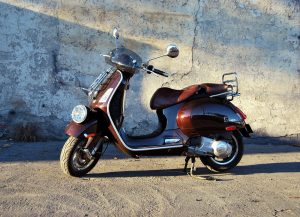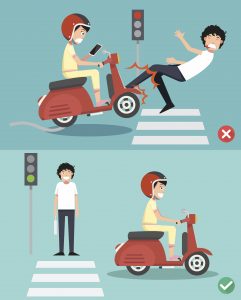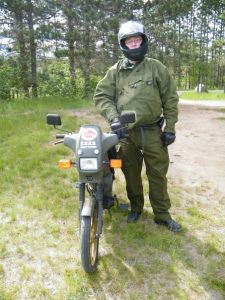Any experienced scooter rider has been there – standing in front of the new or used scooter or small motorcycle you’ve just purchased. Usually with barely adequate protective gear and little or no training because “scooters aren’t real motorcycles” and you’ve been told that you can ride them if you can ride a bike.

And of course you’ve probably been told that scooters are all the same – so you didn’t really pick your new (or new to you) ride based on anything more than colour choice, whether it had the essential go faster stripes, and if it looked like your particular mental image of what a scooter should be – which could be either classic steel or plastic fantastic.
But as a new rider – someone who is just starting out and has never turned a throttle or thrown a leg through a step-through – what should you be looking for in a scooter, and what do you need to start out riding safely? What should be part of your considerations? First of all, you’re going to need to set a budget.

Budgeting for your First Ride:
Here’s a mostly inclusive list of the things you will need to budget for:
- Insurance – the cost of this will vary considerably based on what you are purchasing, your riding experience, where you live and the type of insurance you are getting. Generally anything under 250cc will be comparatively inexpensive to insure, though we recommend you get at *least* three quotes no matter how cheap it is. Insurance costs will vary quite widely, and it’s a good habit to have for any machine. Figure as a new rider you’ll be paying a minimum of $500-600 and this can go up considerably from there depending on your location and other factors.
- Riding gear – the *minimum* gear you should have is a new full face helmet (never buy a used helmet as you don’t know if it has been dropped and it may no longer protect your noggin adequately), a proper motorcycle jacket (textile motorcycle jackets are inexpensive and a good investment – these can be ok to buy used if you check it for wear and tear), and proper motorcycle gloves. Leather work gloves *can* be used in a pinch, but for proper comfort and protection we recommend getting a decent brand name of gloves – it’ll keep your hands blister free on long rides and the skin on your palms if you ever have the misfortune of hitting pavement. You *can* make do to start with jeans and leather boots that cover the ankle, but we also recommend motorcycle pants and boots when possible. A scooter rider going down at 60kph gets just as much damage as a motorcyclist at the same speed – physics doesn’t change because the scooter is cuter or taken less seriously.
- Cost of the scooter – this is another cost that will vary very widely depending on what you are looking for and the area you are in. If you are looking for a used machine, scooter prices can be all over the place depending on factors like brand name, if the model is collectible (Honda Ruckuses for example tend to hold value, but most other 50cc machines drop precipitously in resale price after driving off the dealer lot.) For example I recently purchased a mint low mileage Kymco People 200S for $750 CAD used. This machine needed nothing to certify and was mechanically perfect, but because it was seen as a less collectible model I paid far less for a 160cc+ machine than I would have for a Honda Ruckus 50cc of the same year. Do some research on pricing in your area, have your purchase cash ready and be ready to move if you are buying used. New prices will vary as well – depending on brand and engine size. For a new rider, I’d generally recommend a 125cc machine as these tend to be a sweet spot for insurance, purchase price and possess decent power for a new rider without being on the frightening side when you twist the throttle. Which believe me, some scooters can easily do – small tires plus light weight can make some of them accelerate quite quickly, especially when you get into the maxi-scooter range of machines.
- Maintenance – Are the tires old and in need of replacement? Expect to pay anywhere from $60 a tire to over a hundred, and that doesn’t include the cost of getting them mounted and balanced. Are you doing your own oil changes? (Don’t neglect oil changes, many scooters have primitive oil screens instead of filters and take more frequent oil changes to prevent engine wear and damage). Has the machine been sitting for a while? Even low mileage bikes don’t take well to sitting – expect to replace things like fork seals, mufflers (they rust out from moisture trapped within) and either lube or replace cables.
- Training – I highly recommend taking a motorcycle course when getting your M license. Knowing how to work a clutch and manual shift machine gives you options when it comes to what bikes you can ride, and having motorcycle training can also help reduce insurance – meaning it will pay for itself in the long run. An M2 exit course (which when passed will allow you to get your M2 license) will run about $400 from one of the several training courses available around Toronto.
So that is the financial side of things considered – I know, buzzkill, this is a lot to consider before we get to the vroom vroom bits but unfortunately we’re not done yet. Because we still have to consider – what type of machine should I get?
What should you look for in a first scooter/small motorcycle?
First of all if you are one of those unfortunate people surrounded by folks saying “Don’t get less than XX sized engine, you’ll get bored of it too quick” – don’t listen to them. They’re idiots. Trust me I know as I regularly am either an idiot or am surrounded by them. Smile nicely, nod politely and then listen to this advice:

Don’t get a 50cc, and don’t get a 500cc. There are certainly circumstances in which a 50cc makes sense – right downtown Toronto for example you will rarely reach 60kph, there are few steep hills. They’re also cheaper on insurance admittedly – but it isn’t enough to compensate for the fact that as a new rider you want to be always going at the same speed as traffic. Having cars impatiently pass you on a steep hill, or dodge around you because you are slow accelerating is unsafe at the best of times, and for a new rider you don’t need this extra worry.
At the same time, don’t go for a maxi scooter (250cc+) range of scooter. You’re be paying more for insurance, have a heavier and less nimble bike that is harder to wheel around a parking spot (and you are more likely to drop a heavier bike as a new rider also, though I’ll firmly deny this ever happened to me several times and I’m sincerely sorry Larry and I’ll repaint your machine any day now really.
Get a 125cc.
My personal sweet spot that I would recommend for a new rider is a 125cc machine – most of them will do 80kph which is plenty for downtown riding, insurance is relatively cheap and they are also usually inexpensive on the used market. Up to 250cc can also be a good choice and yes they do offer more long term speed (My Kymco Bet and Win 250 can cruise at 110-120kph for example) – but I think for a new rider the 125cc offers good value, decent speed and power that is still controllable for those still getting used to putting their hands around a twistgrip.
New or used?
New or used tends to be a financial choice – for a new rider with a sufficient budget having a new machine with warranty can be peace of mind against mechanical misadventures. However I generally would recommend looking at a recent model, low mileage used machine. It’s easy to ding or crack or drop a machine as you learn on it, and having a machine you can learn on without worrying about instant depreciation happening due to not paying attention and good old gravity.
Training and starting out.
As mentioned in the budget section, I highly recommend getting training to start – full motorcycle training. These courses will teach you several skills in handling a two wheeled vehicle and allow you to start out in a parking lot environment, learning how to handle a machine without having to handle traffic at the same time.
In general, parking lots and closed roads (if available around you) are the best places to start – setup a few cones (or chairs, or laundry hampers, or particularly brave or tied-up “volunteers”) and practice maneuvering around them. Practice emergency braking, turning in both a circle and in a slalom, and also practice both slow speed and medium speed maneuvering. This is a good idea also when getting a new bike – every scooter handles differently and getting to know the quirks of a machine before heading out into traffic is a great idea. You don’t want any surprises in a panic situation, or finding out when someone
Conclusion:
Buying a scooter can be something that will change your life – giving you a new skilset, new experiences and allow you to meet new people (people are rarely afraid to talk to someone riding a scooter). But you do need to approach it the same way you would with any motorcycle – scooters don’t stop being motorcycles because they’re cute and you need to treat them with the proper respect and take the proper steps for your own safety, comfort, and enjoyment of your new or new to you machine.
We hope these tips help you enjoy a long, fun, and safe scootering career.
